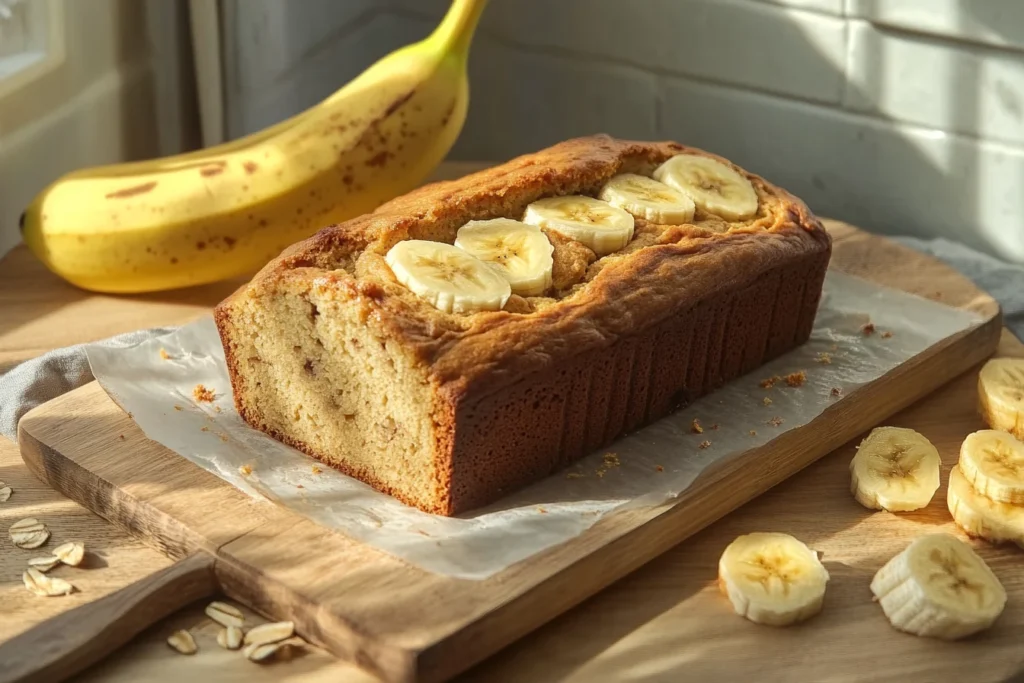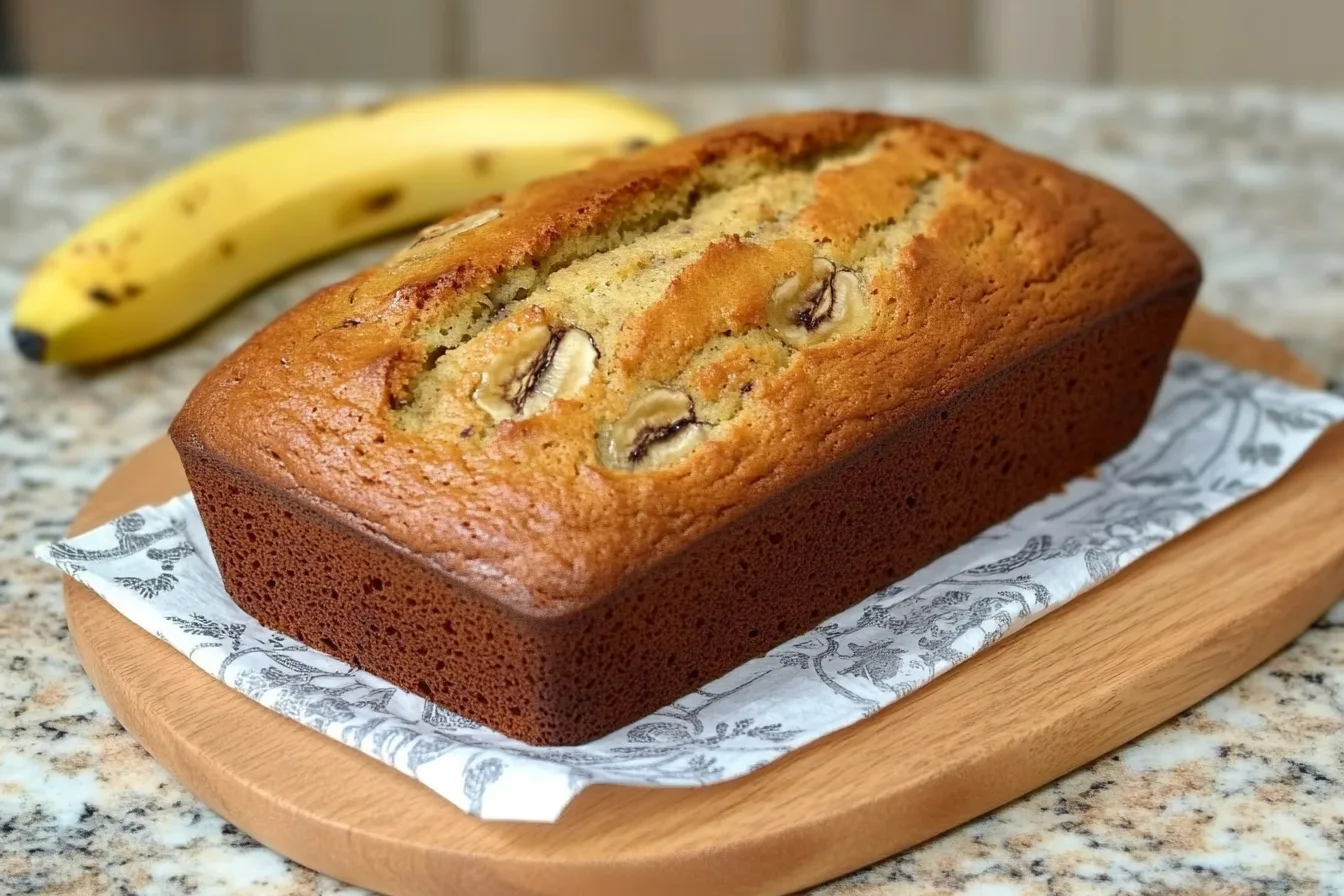Banana bread has been a household favorite for generations, celebrated for its moist texture and sweet, rich flavor. Adding a modern twist to this classic recipe, Chobani yogurt transforms banana bread into a healthier, more nutritious treat without compromising on taste. Whether you’re baking for breakfast, a midday snack, or a family dessert, this Chobani Banana Bread recipe is the ultimate crowd-pleaser.

Why Use Chobani Yogurt in Banana Bread?
Chobani yogurt is more than just a creamy addition; it’s a game-changer in baking. Its tangy flavor balances the sweetness of ripe bananas while its creamy texture ensures a moist crumb. Using yogurt also allows for a reduction in fat, replacing butter or oil in traditional recipes.
Key reasons to use Chobani yogurt in banana bread:
- Moisture and texture: Yogurt keeps the bread tender and prevents dryness.
- Health benefits: High in protein and probiotics, yogurt adds a nutritional boost.
- Versatility: Works well in different banana bread variations.
Benefits of Yogurt in Baking
Adding yogurt to baked goods goes beyond taste. The high protein content and acidity in yogurt interact with baking soda, ensuring a fluffy texture. Plus:
- Improved rise: Yogurt aids in achieving a perfect loaf height.
- Healthier alternative: Reduces the need for extra fats like butter or oil.
- Enhanced flavor: Subtle tang complements the sweetness of bananas and other mix-ins.
Occasions for Enjoying Chobani Banana Bread
This versatile bread suits every occasion:
- Breakfast: Pair with coffee for a balanced morning meal.
- Snack time: Satisfy midday cravings with a slice.
- Gifting: Homemade banana bread makes a thoughtful present.
Ingredients for Chobani Banana Bread
Creating the perfect banana bread starts with choosing the right ingredients. Below, we break down the core components that make this recipe so special.
Core Ingredients for the Bread
1. Bananas: Ripe and Spotty for Sweetness
The secret to flavorful banana bread lies in using overripe bananas. Their natural sugars intensify during ripening, eliminating the need for excess sweeteners.
- Look for bananas with brown spots or a fully blackened peel.
- Store bananas at room temperature until ripened to perfection.
2. Chobani Yogurt: Greek or Regular
Choose plain, unsweetened Chobani yogurt for:
- Moisture: Keeps the bread soft and fluffy.
- Tangy flavor: Balances sweetness perfectly.
Feel free to experiment with flavored Chobani varieties for added flair, like vanilla or honey.
3. Flour: All-Purpose or Whole Wheat
Flour is the backbone of banana bread. Depending on your preference:
- All-purpose flour: For a classic texture.
- Whole wheat flour: For a healthier, nuttier taste.
4. Sweeteners: Brown Sugar, Honey, or Maple Syrup
The sweetener is customizable based on your taste:
- Brown sugar: Adds caramel notes.
- Honey: Provides a natural sweetness.
- Maple syrup: Adds depth and a hint of richness.
Optional Additions for Texture and Flavor
1. Nuts: Walnuts or Pecans
For added crunch, mix in chopped nuts like:
- Walnuts: A classic pairing with bananas.
- Pecans: Offer a buttery richness.
2. Mix-Ins: Chocolate Chips, Raisins, or Blueberries
Enhance your banana bread with these extras:
- Chocolate chips: For a decadent touch.
- Raisins: Add a chewy sweetness.
- Blueberries: Offer bursts of tangy freshness.
3. Spices: Cinnamon, Nutmeg, or Vanilla Extract
Spices elevate banana bread into something extraordinary:
- Cinnamon: Adds warmth and sweetness.
- Nutmeg: Provides a subtle depth.
- Vanilla extract: Enhances all other flavors.
Tools and Equipment Needed
Before diving into the recipe, gather these essential tools to ensure a smooth baking process.
Essentials for Baking Banana Bread
1. Mixing Bowls, Whisk, and Measuring Cups
- Mixing bowls: Use separate bowls for wet and dry ingredients.
- Whisk: Essential for mixing dry ingredients evenly.
- Measuring cups and spoons: Precision is key for consistent results.
2. Loaf Pan or Muffin Tin
Select a baking pan based on your serving preference:
- Loaf pan: For traditional slices.
- Muffin tin: For individual servings.
Specialty Tools for Perfect Banana Bread
1. Potato Masher or Fork for Bananas
Mashing bananas to a smooth consistency ensures even distribution throughout the batter.
2. Silicone Spatula for Easy Mixing
A silicone spatula helps:
- Scrape down bowl sides to avoid waste.
- Gently fold in ingredients without overmixing.
Preparing the Ingredients
A flawless Chobani Banana Bread starts with careful preparation. By ensuring that every ingredient is prepped to perfection, you’ll achieve the ideal texture, flavor, and moisture.
Mashing the Bananas for Smooth Texture
The first and most important step in preparing banana bread is mashing the bananas.
- Choose overripe bananas: These bananas should have a deep brown or black peel, signaling maximum sweetness and softness.
- Mash thoroughly: Use a potato masher or a sturdy fork to mash the bananas into a smooth consistency. Small lumps are acceptable, as they’ll add texture.
Pro tip: Avoid pureeing the bananas completely, as this can make the bread overly dense.
Preparing the Chobani Yogurt for Consistency
Chobani yogurt plays a dual role: it contributes to the bread’s moist texture and balances its sweetness.
- Measure carefully: For most recipes, about ½ cup of yogurt works well.
- Bring to room temperature: This ensures better incorporation with other wet ingredients.
- Choose your style: Use plain Greek yogurt for extra creaminess or regular yogurt for a lighter texture.
If you’d like to explore substitutions for yogurt in baking, refer to this helpful guide.
Measuring and Mixing Dry Ingredients
Dry ingredients serve as the structural foundation of your banana bread. Mixing them properly ensures the loaf rises evenly and has a consistent texture.
Sifting Flour, Baking Soda, and Salt Together
- Flour: Use all-purpose or whole wheat flour, depending on your health goals. Always sift flour to eliminate clumps.
- Baking soda: Acts as the leavening agent, ensuring the bread rises.
- Salt: Enhances flavor and balances sweetness.
Sift these ingredients into a large mixing bowl to aerate the flour and evenly distribute the baking soda.
Adding Spices for Enhanced Flavor
Adding spices to your dry ingredients elevates the flavor profile:
- Cinnamon: Use 1-2 teaspoons for a warm, sweet note.
- Nutmeg: Just a pinch adds depth without overpowering.
- Vanilla powder (if available): A subtle, aromatic enhancement.
Combining Wet Ingredients
The key to moist banana bread is blending wet ingredients into a cohesive, smooth mixture.
Creaming Yogurt, Eggs, and Sweeteners
- Start with yogurt: Add your measured Chobani yogurt to a mixing bowl.
- Whisk in eggs: Crack two large eggs into the bowl and beat until smooth.
- Incorporate sweeteners: Use your choice of brown sugar, honey, or maple syrup. Aim for about ½ cup to strike a balance between sweetness and natural banana flavor.
Incorporating Bananas for a Moist Mixture
Once the wet ingredients are mixed, fold in the mashed bananas gently. This ensures the fruit’s sweetness is evenly distributed without overmixing, which can make the bread dense.
Making the Chobani Banana Bread Recipe
The magic happens when wet and dry ingredients come together. Follow these steps to create a smooth, lump-free batter.
Mixing Wet and Dry Ingredients Together
- Start small: Add the dry ingredients into the wet mixture in thirds.
- Fold gently: Use a silicone spatula to fold the ingredients, avoiding overmixing.
- Monitor consistency: The batter should be thick but pourable. Add a tablespoon of milk or water if it seems too dry.
Folding in Optional Additions Gently
Optional mix-ins like nuts, chocolate chips, or blueberries add texture and flavor:
- Nuts: Fold in ½ cup of chopped walnuts or pecans for crunch.
- Chocolate chips: Add ½ cup for a sweet touch.
- Blueberries: Fresh or frozen work well; toss them in a little flour first to prevent sinking.
Ensuring a Smooth, Lump-Free Batter
After mixing:
- Check for dry streaks of flour.
- Scrape down the sides of the bowl to incorporate all ingredients evenly.
Baking the Chobani Banana Bread Recipe
Now it’s time to bring your batter to life in the oven. Follow these tips for a perfectly baked loaf.
Preparing the Loaf Pan with Grease or Lining
- Grease the pan: Use butter or nonstick spray to coat the inside of your loaf pan.
- Add parchment paper: Line the bottom for easier removal after baking.
If you’re using muffin tins, grease them lightly or use liners.
Pouring and Spreading Batter Evenly
- Pour slowly: Transfer the batter into the prepared loaf pan.
- Spread evenly: Use a spatula to level the batter, ensuring an even rise.
Baking Tips for Perfect Results
Oven Temperature and Timing
- Preheat the oven: Set your oven to 350°F (175°C) for optimal results.
- Bake time: Bake for 50-60 minutes, checking at the 50-minute mark.
- Placement: Place the pan in the center of the oven for even heat distribution.
Testing Doneness with a Toothpick
Insert a toothpick or skewer into the center of the bread:
- If it comes out clean or with a few crumbs, the bread is done.
- If batter sticks, bake for an additional 5 minutes and test again.
Cooling and Serving the Chobani Banana Bread Recipe
Once your Chobani Banana Bread is out of the oven, the next crucial steps are cooling and serving. Properly cooling the loaf ensures it retains its moist texture and is easy to slice. This is also the time to elevate your presentation with thoughtful serving suggestions.
Proper Cooling Techniques to Retain Moisture
Cooling your banana bread correctly prevents sogginess and ensures it holds its structure.
- Cool in the pan: Allow the loaf to rest in the baking pan for 10–15 minutes. This helps it set and makes it easier to remove without breaking.
- Transfer to a wire rack: Carefully lift the bread out using the parchment paper or invert it onto a wire cooling rack. This step allows air to circulate, preventing a soggy bottom.
- Avoid slicing immediately: Let the bread cool completely (at least an hour). Slicing too early can cause it to crumble.
Slicing Tips for Clean Cuts
Achieving neat slices can be tricky if the bread is too warm or not properly cooled.
- Use a serrated knife: A sharp bread knife minimizes crumbling.
- Slice gently: Avoid pressing too hard to maintain the loaf’s shape.
- Cut evenly: Aim for slices about ¾-inch thick to balance structure and portion size.
Serving Suggestions for Any Occasion
Whether serving warm or room temperature, banana bread pairs well with a variety of toppings and beverages.
Toppings: Butter, Honey, or Cream Cheese
- Butter: Spread a pat of butter over a warm slice for a simple, indulgent touch.
- Honey: Drizzle a small amount of honey for added sweetness.
- Cream cheese: Smear on a thin layer of cream cheese for a tangy complement.
Pairing with Beverages Like Coffee or Tea
Banana bread’s flavors are enhanced with the right drink:
- Coffee: A dark roast complements the bread’s sweetness.
- Tea: Choose chai for spice or green tea for a light pairing.
- Milk: A classic option that appeals to all ages.
Variations of Chobani Banana Bread Recipe
The beauty of Chobani Banana Bread lies in its adaptability. From healthier swaps to creative add-ins, there’s a version for everyone.
Healthier Versions with Whole Wheat Flour or Less Sugar
- Whole wheat flour: Swap 100% of the all-purpose flour for whole wheat for added fiber and a nutty flavor.
- Reduce sugar: Use ⅓ cup of sweetener instead of ½ cup for a naturally lighter bread.
- Add seeds: Mix in chia or flaxseeds for extra nutrients.
Vegan and Dairy-Free Substitutions
Making banana bread vegan or dairy-free is simple:
- Substitute yogurt: Use coconut or almond-based yogurt in place of Chobani.
- Egg replacement: Replace eggs with flax eggs (1 tablespoon flaxseed meal + 3 tablespoons water per egg).
- Use plant-based milk: Add a splash of almond or oat milk if needed.
Adding Fruits or Veggies Like Zucchini or Applesauce
- Zucchini: Grated zucchini adds moisture and subtle sweetness without altering the flavor.
- Applesauce: Replace some of the mashed bananas with unsweetened applesauce for a lighter texture and tang.
Tips for Perfect Chobani Banana Bread
Master these tips to ensure every loaf turns out flawless:
Choosing the Best For Chobani Banana Bread Recipe
- Ripeness: Use bananas with more brown spots than yellow for maximum sweetness.
- Storage hack: Freeze ripe bananas if you’re not ready to bake. Thaw them before using for extra sweetness.
Achieving the Right Yogurt-to-Moisture Balance
- Stick to measurements: Too much yogurt can make the bread dense, while too little can make it dry.
- Choose full-fat for richness: Greek yogurt works best for a denser texture, while regular yogurt yields a lighter loaf.
Avoiding Overmixing for Tender Bread
- Fold gently: Overmixing activates gluten, which can lead to tough, chewy bread.
- Mix just until combined: Stop as soon as you see no streaks of dry flour in the batter.
Storing and Freezing Banana Bread
Banana bread stores well, making it perfect for meal prep or as a make-ahead treat.
Best Practices for Short-Term Storage
- Room temperature: Store banana bread in an airtight container or wrapped in plastic wrap for up to 3 days.
- Refrigeration: Extend freshness by storing in the fridge for up to 7 days. Bring slices to room temperature before serving for the best flavor.
Freezing and Reheating Tips for Longevity
- Freezing whole loaves: Wrap the loaf tightly in plastic wrap, then foil. Freeze for up to 3 months.
- Freezing slices: Wrap individual slices for easy grab-and-go snacks.
- Reheating: Warm slices in the microwave for 20–30 seconds or in a toaster oven for a fresh-from-the-oven feel.
Frequently Asked Questions (FAQs)
1. Can I Use Flavored Chobani Yogurt?
Yes! Vanilla or honey-flavored yogurt works well. Avoid overly sweetened varieties, as they may alter the flavor balance.
2. How Do I Make Gluten-Free Banana Bread?
Substitute all-purpose flour with a 1:1 gluten-free baking mix for an easy swap.
3. What Is the Shelf Life of Homemade Banana Bread?
Banana bread lasts 3 days at room temperature, 7 days in the fridge, and up to 3 months in the freezer.
4. Can I Add Protein Powder to This Recipe?
Yes! Add 1-2 scoops of unflavored or vanilla protein powder, reducing the flour by the same amount.
5. Why Did My Banana Bread Sink in the Middle?
This happens if the batter is overmixed or the bread is underbaked. Always test with a toothpick before removing it from the oven.
6. Can I Use Frozen Bananas?
Absolutely! Thaw frozen bananas completely and drain any excess liquid before mashing.
7. How Do I Prevent Mix-Ins From Sinking?
Toss nuts, chocolate chips, or fruit in a little flour before adding them to the batter.
8. Can I Use Other Fruits in Place of Bananas?
Yes! Try mashed pumpkin, applesauce, or grated zucchini for different variations.
9. What’s the Best Way to Warm Up Leftover Banana Bread?
Reheat slices in a microwave for 20–30 seconds or toast lightly for a crispy edge.
10. Can I Make Muffins with This Recipe?
Definitely! Divide the batter into muffin tins and bake at 350°F for 20–25 minutes.
Conclusion: Enjoying Your Chobani Banana Bread Recipe
From selecting the ripest bananas to exploring creative variations, Chobani Banana Bread offers endless possibilities for bakers of all skill levels. By incorporating Chobani yogurt, you achieve a loaf that’s not only moist and flavorful but also packed with nutritional benefits.
So, grab your mixing bowls, invite some friends or family to help, and bake a loaf that’s guaranteed to be a hit! Experiment with toppings, pairings, and substitutions, and most importantly, enjoy every bite.

Chobani Banana Bread Recipe
Equipment
- Mixing bowl
- Whisk
- 9×5-inch Loaf Pan
- Spatula
- Parchment Paper
Ingredients
Main Ingredients
- 3 large ripe bananas mashed
- 1/2 cup Chobani yogurt plain or vanilla
- 1/2 cup unsalted butter melted
- 3/4 cup granulated sugar
- 2 large eggs room temperature
- 1 teaspoon vanilla extract
- 2 cups all-purpose flour
- 1 teaspoon baking soda
- 1/4 teaspoon salt
- 1/2 cup chopped walnuts optional
Instructions
- Preheat your oven to 350°F (175°C). Grease a 9×5-inch loaf pan or line it with parchment paper.
- In a mixing bowl, mash the ripe bananas with a fork. Add the Chobani yogurt, melted butter, sugar, eggs, and vanilla extract. Whisk until smooth.
- In another bowl, whisk together the flour, baking soda, and salt. Gradually add the dry ingredients to the wet ingredients, mixing until just combined.
- If using, fold in the chopped walnuts gently with a spatula.
- Pour the batter into the prepared loaf pan and smooth the top with a spatula.
- Bake in the preheated oven for 60 minutes, or until a toothpick inserted into the center comes out clean.
- Allow the banana bread to cool in the pan for 10 minutes before transferring to a wire rack to cool completely. Slice and serve.
